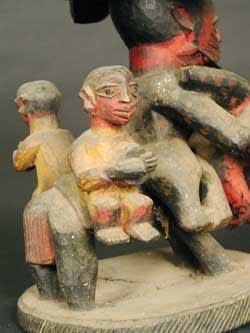Yoruba Wooden Polychrome Container, 19th Century CE - 20th Century CE
Wood
8.5 x 15
PF.3991 (LSO)
Further images
This complex polychrome anthropomorphic vessel was made by the Yoruba of Nigeria, arguably one of Africa’s most important groups in terms of artistic heritage. It shows a man riding a...
This complex polychrome anthropomorphic vessel was made by the Yoruba of Nigeria, arguably one of Africa’s most important groups in terms of artistic heritage. It shows a man riding a horse, accompanied by two smaller figures – perhaps his children – sitting with their legs hanging over each side of their long-suffering mount. The main figure is mature, with a large beard and triple scars on each cheek and his forehead. The bridle is extended and resembles yoke, which the rider is gripping with upwards-facing hands. The vessel is attached to the apex of his head, comprising a round bowl with attacked lid. The body is decorated with geometric motifs, the lid with an animal which appears to be a crocodile, seizing another in its mouth, and flanked by what are perhaps intended to be mudfish motifs. The latter are symbolic of harmony and good fortune, the crocodile of Olokun, the god of water and the sea. The surface is worn, and has received indigenous repair to the bowl.
The Yoruba peoples of Nigeria have what is probably the longest extant artistic tradition in Africa. The nation state is comprised of numerous subsections that were joined historically by the rise and collapse of the Ife (12th to 15th centuries) and Benin (13th to 19th centuries) polities. Each of the sub-kingdoms – including Oyo, Ijebu and smaller units towards the west – had their heyday, and are loosely united through language and culture, although they still retain a measure of independence in terms of their artistic traditions.
The Yoruba are sedentary, agriculturist and hierarchical, and are ruled by hereditary kings known as Obas. Access to the supernatural world is supervised by a very complex arrangement of priests and spiritual intermediaries, who straddle the cosmological border between the tangible realm of the living (aye) and the invisible realm of the spirits and the hereafter (orun). The creator of the world is Olodumare – the source of all ase (life force) – and his spiritual minions include all manner of spirits, gods and ancestors who can be appealed to or appeased through human intermediaries. Most Yoruban artistic heritage is designed to thwart evil spirits, and to placate or honour those that bring good fortune to the populace.
Without contextual information, the function of this item is uncertain. Given its dimensions, it is unlikely to be a domestic food container, and it is instead more likely to have occupied a ritual role, or perhaps for the storage of precious items in the same manner as Akan people store their valuables in kuduo vessels. This is an impressive piece of African art.
The Yoruba peoples of Nigeria have what is probably the longest extant artistic tradition in Africa. The nation state is comprised of numerous subsections that were joined historically by the rise and collapse of the Ife (12th to 15th centuries) and Benin (13th to 19th centuries) polities. Each of the sub-kingdoms – including Oyo, Ijebu and smaller units towards the west – had their heyday, and are loosely united through language and culture, although they still retain a measure of independence in terms of their artistic traditions.
The Yoruba are sedentary, agriculturist and hierarchical, and are ruled by hereditary kings known as Obas. Access to the supernatural world is supervised by a very complex arrangement of priests and spiritual intermediaries, who straddle the cosmological border between the tangible realm of the living (aye) and the invisible realm of the spirits and the hereafter (orun). The creator of the world is Olodumare – the source of all ase (life force) – and his spiritual minions include all manner of spirits, gods and ancestors who can be appealed to or appeased through human intermediaries. Most Yoruban artistic heritage is designed to thwart evil spirits, and to placate or honour those that bring good fortune to the populace.
Without contextual information, the function of this item is uncertain. Given its dimensions, it is unlikely to be a domestic food container, and it is instead more likely to have occupied a ritual role, or perhaps for the storage of precious items in the same manner as Akan people store their valuables in kuduo vessels. This is an impressive piece of African art.
Literature
V19









